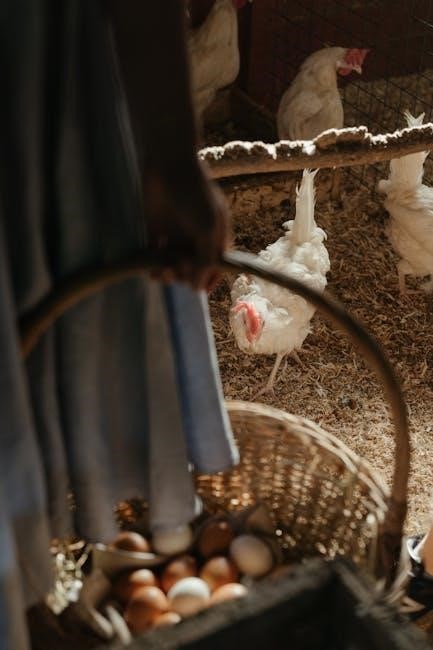The poem I Know Why the Caged Bird Sings is a powerful exploration of freedom, identity, and resilience. Written by Maya Angelou, it reflects her autobiographical journey, resonating deeply with themes of social justice and personal liberation. The vivid imagery and emotional depth have made it a timeless classic, inspiring readers globally. Its connection to her autobiography underscores the universal struggle for equality and self-discovery.
1.1 Overview of the Poem and Its Significance

I Know Why the Caged Bird Sings is a poignant poem by Maya Angelou, exploring themes of freedom, oppression, and resilience. The poem delves into the emotional journey of a caged bird, symbolizing the struggles of marginalized communities. Its vivid imagery and heartfelt tone resonate deeply, making it a powerful statement on social justice. The poem’s significance lies in its ability to convey universal emotions while addressing specific experiences of racism and inequality. It has become an iconic representation of the struggle for liberation and self-expression, inspiring countless readers worldwide. The poem’s accessibility in PDF format has further amplified its reach, allowing it to be studied and appreciated across generations.

1.2 Historical Context and Background
The poem I Know Why the Caged Bird Sings is deeply rooted in the historical context of racial inequality and personal struggle. Written by Maya Angelou in 1969, it reflects her experiences growing up in a segregated America during the Civil Rights Movement. The poem draws inspiration from her autobiography of the same name, which chronicles her early life and the challenges she faced. The title itself is inspired by a song from the 1941 movie Sun Valley Serenade, performed by Glenn Miller, symbolizing the longing for freedom. Angelou’s work became a powerful voice for marginalized communities, offering a poignant reflection on resilience and the fight for equality. The historical backdrop of oppression and resistance underscores the poem’s enduring relevance and emotional impact.

The Poem and Its Themes
The poem explores themes of freedom, oppression, and identity through the metaphor of a caged bird, symbolizing the longing for liberation and equality.

2.1 The Metaphor of the Caged Bird
The metaphor of the caged bird serves as a powerful symbol of confinement and the longing for freedom. The bird, trapped yet singing, represents resilience and the desire to break free from oppression. Its song is a cry of both sorrow and hope, reflecting the emotional depth of those who endure injustice. The caged bird contrasts with the free bird, which soars effortlessly, highlighting the disparity between oppression and liberation. This imagery is central to the poem, symbolizing the struggles of marginalized communities and the universal human quest for freedom. Through this metaphor, the poem conveys the pain of confinement and the unyielding spirit that yearns for release, making it a poignant representation of the fight against racial and social inequality.
2.2 Freedom, Identity, and Social Justice
At the heart of I Know Why the Caged Bird Sings lies the intertwining themes of freedom, identity, and social justice. Freedom is portrayed not just as a physical state but as an emotional and psychological liberation from societal constraints. The poem explores the tension between oppressive systems and the human spirit’s desire to break free. Identity, particularly racial identity, is a central focus, as the speaker grapples with self-discovery and the burdens of systemic racism. Social justice emerges as a call to action, urging readers to confront inequality and advocate for change. Through vivid imagery and personal reflection, the poem underscores the resilience of marginalized communities and the universal struggle for dignity and equality. These themes resonate deeply, making the poem a powerful voice for justice and self-expression.

The Autobiography and Its Connection to the Poem
The autobiography mirrors the poem’s themes of resilience and self-discovery, reflecting Maya Angelou’s journey through racial inequality and personal liberation, deeply connecting her life to the caged bird’s struggle.
3.1 Maya Angelou’s Autobiographical Work
Maya Angelou’s autobiographical work, particularly I Know Why the Caged Bird Sings, is a seminal piece of African American literature. Published in 1969, it marked a turning point in autobiographical writing, blending lyrical prose with unflinching honesty. The book recounts her early life, navigating racism, identity, and personal struggles, resonating deeply with readers. Its success lies in its universal themes of resilience and self-discovery, while remaining deeply rooted in her specific experiences as a Black woman in America. The autobiography mirrors the poem’s central metaphor of confinement and liberation, reflecting Angelou’s journey from silence to voice, captivity to freedom. Her work not only chronicles her life but also amplifies the voices of the marginalized, making it a powerful testament to the human spirit.
Angelou’s writing style, both poetic and plainspoken, has inspired countless readers, cementing her legacy as a literary icon.
3.2 How the Poem Reflects Her Life Experiences
The poem I Know Why the Caged Bird Sings deeply reflects Maya Angelou’s life experiences, particularly her struggles with racism, identity, and personal resilience. The caged bird symbolizes her confinement within societal constraints, while the free bird represents her longing for liberation and self-expression. Angelou’s childhood in the segregated South, her feelings of alienation, and her journey toward self-discovery are mirrored in the poem’s vivid imagery. The poem also echoes her silenced voice during periods of personal trauma, such as her childhood rape and subsequent muteness, as well as her eventual empowerment through poetry and storytelling.
Through the poem, Angelou transforms her pain into beauty, creating a powerful reflection of her life’s journey from oppression to freedom and self-realization.
Literary Analysis and Interpretation
The poem offers profound insights into themes of oppression, freedom, and resilience through its rich symbolism and evocative imagery, resonating deeply with readers seeking emotional and intellectual connection.
4.1 Symbolism in the Poem
The poem “I Know Why the Caged Bird Sings” is rich in symbolism, with the caged bird representing oppression, confinement, and the longing for freedom. The cage itself symbolizes societal constraints, such as racism and sexism, that trap individuals. The bird’s song, though muffled, signifies resilience and the enduring hope for liberation. In contrast, the free bird embodies freedom, joy, and the unencumbered spirit, highlighting the stark contrast between captivity and liberty. The poem also uses natural imagery, like the sky and wind, to symbolize vast possibilities and the yearning for escape. Through these symbols, Maya Angelou conveys the emotional and psychological struggles of marginalized individuals, emphasizing the universal desire for autonomy and self-expression. The interplay of these symbols creates a powerful narrative that resonates deeply with readers, inviting reflection on freedom, identity, and societal barriers.
4.2 The Role of Nature in the Poem
Nature plays a pivotal role in “I Know Why the Caged Bird Sings,” serving as a backdrop to explore themes of freedom and confinement. The sky and wind symbolize vastness and liberation, contrasting sharply with the caged bird’s restricted existence. The poem uses natural imagery to evoke emotional depth, with the free bird’s flight representing unbridled joy and the caged bird’s struggle mirroring the human desire for release. The juxtaposition of natural beauty with the harsh reality of captivity underscores the universal longing for freedom. Through nature, Angelou highlights the resilience of the spirit and the enduring hope for escape, even in the face of oppression. This imagery not only enriches the poem’s emotional landscape but also deepens its exploration of identity and societal constraints.
The Song “I Know Why” and Its Cultural Impact
The 1941 song by Glenn Miller inspired Angelou’s poem, reflecting themes of longing and freedom. Its enduring popularity highlights its cultural resonance and emotional depth.
5.1 The 1941 Song by Glenn Miller
The 1941 song I Know Why by Glenn Miller and his orchestra became a timeless classic, capturing the essence of longing and hope. Originally performed by Miller’s band, the song’s title inspired Maya Angelou’s iconic poem. Its melancholic melody and poignant lyrics resonated deeply with audiences during wartime, offering solace and reflection. The song’s popularity soared, making it one of Miller’s most celebrated recordings. Its cultural significance lies in its ability to evoke universal emotions, transcending generations. The song’s legacy endures as a symbol of resilience and the human spirit’s quest for freedom, aligning with the themes explored in Angelou’s work. This connection highlights the profound impact of art on societal consciousness and personal expression.

5.2 Its Popularity and Legacy
The song I Know Why gained immense popularity upon its release in 1941, becoming a chart-topping hit and a staple of the Glenn Miller Orchestra’s repertoire. Its haunting melody and evocative lyrics resonated with listeners during a tumultuous era, offering both solace and reflection. The song’s enduring legacy is evident in its continued presence in popular culture, with covers by numerous artists and frequent appearances in films, television, and documentaries; Its timeless appeal lies in its universal themes of longing and hope, which transcend generations. The song’s influence extends beyond music, inspiring literary works like Maya Angelou’s poem, thereby cementing its place in both musical and cultural history. Its lasting impact highlights the power of art to evoke emotion and inspire creativity across mediums.

Accessing the Poem and Related Works

The poem and related works can be easily accessed through various online platforms and libraries. A PDF version is widely available for download, ensuring easy readability and sharing. Additionally, exploring related literary works and analyses can deepen understanding and appreciation of the poem’s themes and significance.
6.1 Where to Find the PDF Version
The PDF version of I Know Why the Caged Bird Sings can be accessed through various online platforms and educational resources. Many websites offer free downloads, while others may require purchase or subscription. Popular options include online libraries, academic databases, and e-book platforms like Amazon Kindle or Google Books. Additionally, some educational institutions provide access to the poem and related materials through their digital archives. It is important to ensure that the source is reliable and respects copyright laws. For those unable to access digital versions, local libraries often carry physical copies or can assist with interlibrary loans. Searching with specific keywords, such as “I Know Why the Caged Bird Sings poem PDF,” can yield direct links to downloadable versions. Always verify the credibility of the source before downloading.
6.2 Recommended Reading Companions
For a deeper understanding of I Know Why the Caged Bird Sings, several companion texts are highly recommended. Maya Angelou’s subsequent autobiographies, such as Gather Together in My Name and The Heart of a Woman, provide further insight into her life and themes. Additionally, works by other prominent African American authors, like To Kill a Mockingbird by Harper Lee and The Souls of Black Folk by W.E.B. Du Bois, offer contextual richness. Poetry collections by Langston Hughes and Countee Cullen also resonate with the poem’s themes of identity and social justice. These works complement the emotional and historical depth of Angelou’s writing, offering a well-rounded literary experience. Exploring these companions enhances the reader’s appreciation of the poem’s significance and its place in American literature.
I Know Why the Caged Bird Sings remains a powerful exploration of freedom, resilience, and identity. Maya Angelou’s words continue to inspire, offering timeless relevance and universal appeal.
7.1 The Timeless Relevance of the Poem
The timeless relevance of I Know Why the Caged Bird Sings lies in its universal themes of freedom, resilience, and identity. Maya Angelou’s vivid imagery and emotional depth resonate across generations, transcending time and culture. The poem’s exploration of social justice and personal struggle continues to inspire, offering hope and reflection in an ever-changing world. Its ability to evoke empathy and self-reflection ensures its enduring appeal, making it a cornerstone of American literature. The poem’s message of liberation, both literal and metaphorical, remains a powerful call to action, encouraging readers to confront inequality and seek empowerment. Its relevance endures as a testament to the human spirit’s capacity for growth and transformation.
7.2 Encouragement to Explore Further

Exploring I Know Why the Caged Bird Sings further offers a profound journey into themes of freedom, identity, and resilience. The poem’s layered meanings invite multiple interpretations, encouraging readers to uncover its depth. Delving into Maya Angelou’s autobiography provides a richer understanding of her life experiences that shaped the poem. Additionally, examining the historical context of the Civil Rights Movement adds perspective to its themes. Analyzing the poem’s literary devices, such as symbolism and imagery, enhances appreciation of its artistry. Reading related works, like her other poetry and essays, reveals her literary genius. Engaging with discussions and analyses online or in book clubs can offer new insights. This exploration not only enriches one’s understanding of the poem but also fosters a deeper connection to its universal themes, making it a rewarding and enlightening experience.